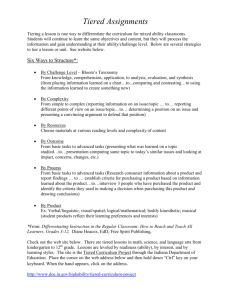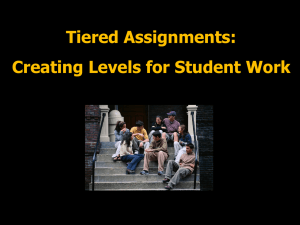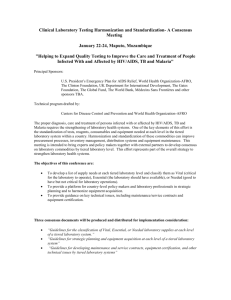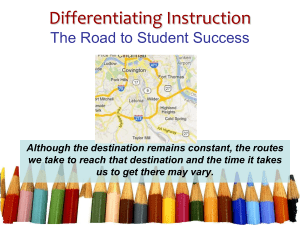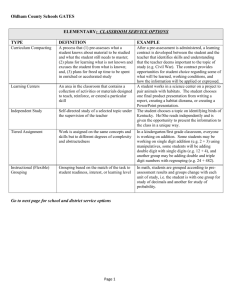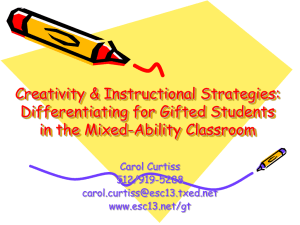Differentiation in the Classroom - Arch Ford Education Service
advertisement
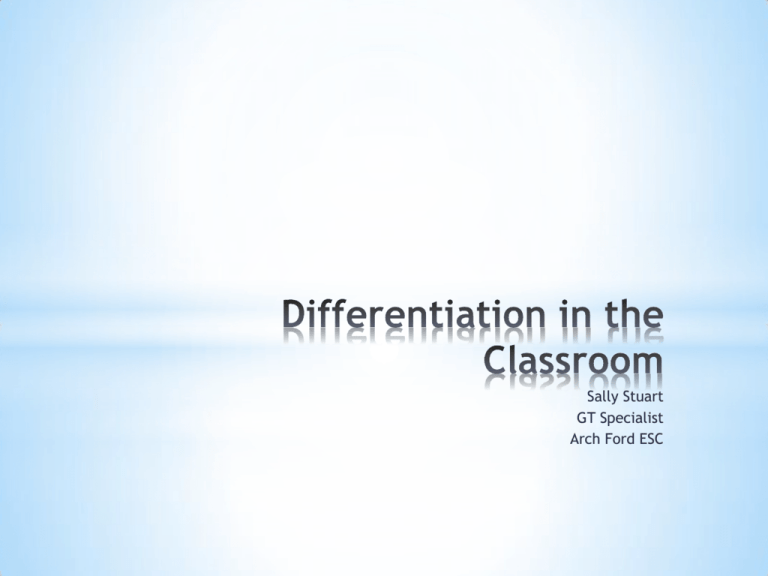
Sally Stuart GT Specialist Arch Ford ESC See Link What is Differentiation? Differentiation is classroom practice that looks eyeball to eyeball with the reality that kids differ, and the most effective teachers do whatever it takes to hook the whole range of kids on learning. Tomlinson (2001) 3 What is Differentiation? 4 1. They can be delightful but can also be demanding, impatient, perfectionist, sarcastic, and disruptive. 2. Few regular education teachers have received sufficient training in issues related to gifted education. 3. The IDEA is founded on the belief that all students have the right to instruction appropriate to their needs. 1. The pace in which they learn 2. The depth of their understanding 3. The interests they hold * Identify gifted students in their classroom. * Utilize methods for differentiating instruction. * Facilitate cooperation with parents and other teachers. * Become effective team members in developing the gifted child’s education plan. * Monitor gifted child’s needs. * Locate and select appropriate materials for gifted. * Utilize community resources to extend and supplement classroom activities. Multiple Intelligence Learning Styles Thinking Styles Know your students What is your Learning Strength? * Multiple Intelligence Survey * Learning Style Quiz (Edutopia) * Learning Questionnaire 10 Verbal/Linguistic Logical/Mathematical Visual/Spatial Musical/Rhythmic Bodily/Kinesthetic Interpersonal Intrapersonal Naturalist Chart results Howard Gardner Auditory Visual Tactile Kinesthetic Tactile/Kinesthetic Concrete Random Concrete Sequential Abstract Sequential Abstract Random Anthony Gregorc 1982 Content Selected according to student interest Interdisciplinary or accelerated Content * Issues * Urban vs. Suburban and Rural Life Styles * Good vs. evil * Helpful and harmful effects of technology * Etc. * Problems * Life in the future * Conservation * Human Relations * Decay of big Cities * Effect of Current Events on Public Morale * Etc. * Themes * Courage * Communication * Patters of change * Etc. Content Process Rather than content emphasis Bloom’s Creative Problem Solving Critical Thinking Cubing Etc. Process * Emphasize on: * Flexibility * Inquiry * Discovery * Investigation * Creativity * Develop skills of * Analysis * Synthesis * Evaluation * Creative, productive, divergent thinking Content Process Product Product * Kinesthetic * Model * Diorama * Sculpture * Puzzle * Written * Journal * Report * editorial * Oral * Panel discussion * Debate * Teaching a lesson * Video * Visual * Display * Charts * Collage * Mural * Time line * Diagram * Various Research Designs: * Experimental, correlational, historical, descriptive, case study * Skills: * Observation reporting, notetaking, interviewing, questionnaire construction and analyses of data etc. Research 20 * 1. Tiering 22 Tiering *Tiered assignments are a differentiation strategy where learning tasks and projects are developed based on assessed student need. *Tiered assignments are intended to provide a better instructional match between students and their needs. 23 Tier by. . . Challenge level (Depth) Complexity Resources Outcome Process Product There are multiple methods for designing Tiered Assignments In designing a Standards-based tiered lesson: * * * Start with grade-level standards, concepts or skills Modify the content into two to three progressive levels of depth and complexity Differentiate by process, product, resources or outcome Research, Interview, Read book, Use Internet…. Perform, create, present, write…. Common Core State Standards Mathematics Numbers & Operations and Base Ten Grade 5 Grade and Standard Typical Learner Gifted Learner 5.NBT.B.6—Perform operations with multi-digit numbers and with decimals to hundredths. Students will be given word problems which require them to determine the mean of a series of 10 or more numbers whose sums are three or four digit numbers. Students will determine the mean of 10 or more numbers taken from the real world whose sum is a three or four digit number. Find whole-number quotients of whole numbers with up to fourdigit dividends and two-digit divisors, using strategies based on place value, the properties of operations, and/or the relationship between multiplication and division . Illustrate and explain the calculation by using equations, rectangular arrays, and/or area models. Example: Students will survey a group of students (classroom, random group Example: Find the mean from playground, students in of the following GT class, etc.) to determine numbers: 188, 204, 370, the ages of the children in 123, 532, 872, 211, 553, that group. They will then 612, 903. use the data to determine the mean of the ages of that group of children. Let's look at some examples Subject: ELA Standards for Speaking and Listening Strand and Number: Presentation of Knowledge and Ideas # 4 Grade-Level Outcomes in Knowledge and Skills: Present information, findings, and supporting evidence such that listeners can follow the line of reasoning and the organization, development, and style are appropriate to task, purpose, and audience. Grade & Standard Typical Learners Advanced Learners Grades 3 SL.3.4. Report on a topic or text, tell a story, or recount an experience with appropriate facts and relevant, descriptive details, speaking clearly at an understandable pace. Grade 5 SL.5.4. Report on a topic or text or present an opinion, sequencing ideas logically and using appropriate facts and relevant, descriptive details to support main ideas or themes; speak clearly at an understandable pace. Students will tell stories orally to their classmates in an engaging manner about how the students’ families celebrate something. Students will research the history of a particular family celebration and include the information in an engaging oral presentation to the public during a school-wide family night. Students will report orally about a local issue in the news in an engaging, clear manner with a main idea, facts, and supporting details. After selecting a local news issue, students will hold a debate about the issue representing various perspectives. HS.1 Structure and Function: HS.1.PS.1 Describe the atomic model and explain how electron configuration is related to the Periodic Table and to chemical properties. Compare and contrast the atomic model, electron configuration and chemical properties of an alkali metal, halogen, and noble gas and explain the placement of each in the periodic table. Based on the atomic model, electron configuration and chemical properties of an alkali metal, halogen, and noble gas, explain the placement of each in the periodic table and create a method for describing the chemical properties of other elements based on their relative position to these elements in the periodic table. Click here for more examples. High School example of Tiering by Depth and Complexity within a Standard Level 1 Activities * Use the first page as a title page with the title, your name and an illustration for your story. * Write your small moment across the other three pages of your booklet. The writing is in the form of pictures and a few words. Add details so that we can see and you can read to us the story when you finish! Label your pictures. (example – the letter ”D” or the word “Dog” next to the picture of a dog) Level 2 Activities * Use the first page as a title page with the title, your name and an illustration for your story. * Write your small moment across the other three pages of your booklet. Each page should have at least one picture and one sentence at the bottom of the page that tells what is happening in the picture. Level 3 Activities * Use the first page as a title page with the title, your name and an illustration for your story. * Write your small moment across the three page booklet with a picture and two or more detailed sentences at the bottom of each page. Use descriptive words in your story and make sure your sentences match what is happening in the picture. Be sure to have a closure at the end of your story. Carolyn Coil - CCSS Students work at mixed degrees of difficulty on a tasks, all explore the same essential ideas and work at different levels of thought. Groups will eventually come together to share and learn from each other. Tiered assignments should be: -Different work, not simply more or less work -Equally active -Equally interesting and engaging -Fair in terms of work expectations and time needed -Requiring the use of key concepts, skills, or ideas Examples Tiered Assignments 30 Overview of Tiering http://help4teachers.com/ http://challengebychoice.wordpress.com/ 31 2. Exit Slips/On going Assessments 32 * Student Daily Assessment as Differentiation Example 1 Example 2 Click above for YouTube video example 33 * • • • • Questioning K-W-L Chart Entrance and Exit slips CATs (not the furry kind) Classroom Assessment Techniques (click on CATs for website) 34 3. GROUPING 35 *Students need to be taught the skills for working cooperatively in groups in order for group work to be successful 8:42 min. Video Tiering Exit Cards/On going Assessment Grouping 37 4. LEARNING MENUS 38 * Menu examples * Tic Tac Toe (Think Tac Toe) * Choice Boards * Menu Differentiating with Learning Menus 39 More Learning Menus * Think Tack Toe * * * Tic-tac-toe Extended menus Choice Board Packet 40 * Example Menus *Dare to Differentiate *Learning menus 41 5. Anchor Activities 42 * Click picture above for YouTube Video ex. 43 6. LEARNING CONTRACTS 44 * What are Learning Contracts? Blank Contract Learning Contract examples 45 7. Cubing and more 46 * Cubing Criteria Cards Curriculum Compacting ILP (Individual Learning Plan) Questivitiesk 47 8 Ways of Learning Multiple Intelligence *Cubing Activity 48 Click picture for a link * * Lillian Katz * 51 *Cubing *Learning Contracts *Learning menus *Criteria cards *Ongoing assessment *Anchor Activities * 1. Write informative/explanatory texts to examine and convey complex ideas and information clearly and accurately through the effective selection, organization and analysis of content. 2. Gather relevant information from multiple print and digital sources, assess the credibility and accuracy of each source and integrate the information while avoiding plagiarism. What is the United States’ role and scope of government? Understand the limitations/weaknesses of the Articles of Confederation. Students will create a project to defend the AofC. (see tiered activities) Be able to explain reasons for calling a Constitutional Convention. Connect historical problems to current problems. Students will explain the AofC Has notes and questions as required. Accurate and complete. Class list has major weaknesses and problems. All participate in discussion. Tiered activities based on student ability Example Is there anything we can learn from history that can help others countries today? Is there anything we can learn from this period in history that can help us with our current political concerns? Tier 1 Tier 2 Tier 3 Complete after lesson based on student need Know your students and what tier you would give. 53 Pg. 12 * http://www.diffcentral.com/examples/DifferentiationCentral LessonTemplate.pdf * 54 * Example 1 * Example 2 * Example 3 Email me for these copies * * * * * * * * * * * * * * * * * * * * * * Videos: http://www.youtube.com/watch?v=Omx_iLtMjZA http://www.youtube.com/watch?NR=1&feature=fvwrel&v=Omx_iLtMjZA http://www.differentiationcentral.com/videos.html#introduction http://www.diffcentral.com/Video_Clips.html#second http://www.teachingchannel.org/videos/new-teacher-survival-guide-differentiating-instruction?fd=0 https://www.teachingchannel.org/videos/differentiating-instruction-strategy https://www.teachingchannel.org/videos/student-daily-assessment https://www.youtube.com/watch?v=kZxNldBEU6o https://www.youtube.com/watch?v=0C10VDEoChg http://www.celt.iastate.edu/teaching/cat.html https://www.youtube.com/watch?v=Jk2n6uRQHog Project menus: http://www.pvusd.k12.ca.us/departments/GATE/choiceboards/MeaningfulMenus.pdf Project Wiki: http://blog.wikispaces.com/2011/08/projects-a-better-way-to-work-in-classroom-groups.html Think Tac Toes: http://www.bedfordk12tn.com/education/components/scrapbook/default.php?sectiondetailid=1153 http://daretodifferentiate.wikispaces.com/Choice+Boards Power Point on Think Tack Toe: http://www.google.com/url?sa=t&rct=j&q=&esrc=s&source=web&cd=2&ved=0CDQQFjAB&url=http%3A%2F%2Fdaretodifferentia te.wikispaces.com%2Ffile%2Fview%2FThink%2BTac%2BToe.ppt&ei=ybuuTqD2LqmusQKF1szkDg&usg=AFQjCNG7t1fTjTvwTR6COK CKYj5OqAU0fg * 56 Overview of Tiering: * * * * * * * * * * * * * * * * * * * * * * * * http://www.derry.k12.nh.us/dvs/staff/cmccallum/differentiation/tiered.pdf http://www.saskschools.ca/curr_content/bestpractice/tiered/index.html http://help4teachers.com/ http://challengebychoice.wordpress.com/ Examples of contracts: http://wblrd.sk.ca/~bestpractice/contract/examples.html http://www.iu29.org/resources/Documents/StudLearnContract.pdf http://olc.spsd.sk.ca/DE/PD/instr/strats/learningcontracts/index.html http://www-distance.syr.edu/contract1.html http://wsddifferentiation.wikispaces.com/file/view/Learning+Contract.pdf Differentiating strategies: http://www.teachersworkshop.com/twshop/differentiatedideas.html http://www.appomattox.k12.va.us/acps/attachments/6_6_12_dan_mulligan_handout.pdf http://www.adifferentplace.org/teachers.htm http://k5di.pottsgrove.wikispaces.net/ http://www.teachersworkshop.com/n http://www.diffcentral.com/index.html Teaching Channel videos licensing agreement: http://creativecommons.org/licenses/by-nc-nd/3.0/ Other: http://www.ascd.org/publications/books/198179/chapters/Powerful-Learning-in-Schools.aspx http://www.literacyworks.org/mi/assessment/findyourstrengths.html http://www.edutopia.org/multiple-intelligences-learning-styles-quiz http://www.vark-learn.com/english/index.asp * 57 *
